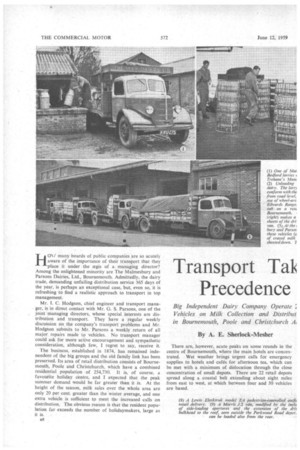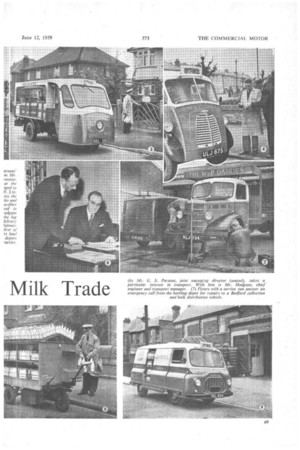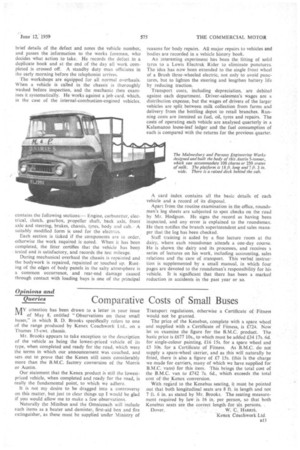Transport Tat Precedence Milk Trade
Page 42

Page 43

Page 44

Page 47

If you've noticed an error in this article please click here to report it so we can fix it.
Big Independent Dairy Company Operate Vehicles on Milk Collection and Distribut in Bournemouth, Poole and Christchurch A, By A. E. Sherlock-Mesher
many boards of public companies are so acutely aware of the importance of their transport that they place it under the aegis of a managing director? Among the enlightened minority are The Malmesbury and Parsons Dairies, Ltd., Bournemouth. Admittedly, the dairy trade, demanding unfailing distribution service 365 days of the year, is perhaps an exceptional case, but, even so, it is refreshing to find a realistic approach to transport in top management.
Mr. I. C. Hodgson, chief engineer and transport manager, is in direct contact with Mr. G. S. Parsons, one of the joint managing directors, whose special interests are distribution and transport. They have a regular weekly discussion on the company's transport problems and Mr. Hodgson submits to Mr. Parsons a weekly return of all major repairs made to vehicles. No transport manager could ask for more active encouragement and sympathetic consideration, although few, I regret to say, receive it.
• The business, established in 1874, has remained independent of the big groups and the old family link has been preserved. Its area of retail distribution consists of Bournemouth, Poole and Christchurch, which have a combined residential population of 254,730. It is, of course, a favourite holiday centre, and I expected that the peak summer demand would be far greater than it is. At the height of the season, milk sales over the whole area are only 20 per cent, greater than the 'winter average, and one extra vehicle is sufficient to meet the increased calls on distribution. The obvious reason is that the resident population far exceeds the number of holidaymakers, large as it is. B8 There are, however, acute peaks on some rounds in the centre of Bournemouth, where the main hotels are concentrated. Wet weather brings urgent calls for emergency supplies to hotels and cafés for afternoon tea, which can be met with a minimum of dislocation through the close concentration of small depots. There are 22 retail depots spread along a coastal belt extending about eight miles from east to west, at which between four and 30 vehicles are based. Branches are supplied from a floe modern dairy in the north-eastern area of Bournemouth. It was built in 1954 and is architecturally pleasing as well as functionally efficient. It is designed for flow processing and occupies an island site around which a one-way traffic system is maintained. It has a capacity. of 3,000 gallons of processed milk an hour and employs about 60 people.
Milk arrives daily from farms within a 25-mile radius of the dairy. More than half of it is delivered by farmers and hauliers. The remainder is collected by Malmesbury and Parsons' own lorries, which are used also for distribution of. bottled and crated milk to retail depots. On arrival at the dairy, churns are unloaded from the side of the vehicle at two covered intake points on to chain conveyors. Empty bottles are similarly unloaded at three adjoining bays, all with roller shutters. On the-other side of the building are seven scrupulously clean, tiled bays for outgoing loads of crated milk. The bay floors are rather low-3 ft. 2 in. above road level—and to restrict lorry platforms to that height, wheel-arches are necessary. They can, however, be used as load-carrying platforms.
Quality Control Strict bacteriological control is maintained over the incoming milk by a modern laboratory and the company go a stage further by insisting that all bottled milk, when being delivered from the dairy to retail depots, is fully sheeted to give maximum protection.
Milk may also be drawn from the associated concern of Edward phillips and Son, who have a creamery at Okeford Fitzpaine, near 131andford, for the production of Cheddar cheese and cream, and act as a milk-collection depot. The Malmesbury and Parsons organization includes also an egg-packing station adjacent to the main dairy.
Two-thirds of the fleet of 291 vehicles are driven or pedestrian-controlled threeor four-wheeled electries. Seventy-nine more have petrol engines and two are oilers The electrics are of Brush, Douglas, Graisley, Lewis Electruk, Morrison-Electricar, Midland, N.C.B., Tomlinson and Wales and Edwards makes. The petrol vehicles comprise Austin, Bedford, Bradford, Commer, Chevrolet, Thames, Morris and Standard. The Chevrolet and Cornmer are breakdown outfits.
The two oilers are both from the B.M.C. stable. One is a 2.2-litre stores van and the other a 5-tonner with a 5.1-litre six-cylindered engine. A forward-control chassis has been selected for the 5-tonner to give the driver better visibility when leaving blind exits from farms and depots.
Designed for the Job
The bodywork has been designed and built in Malmesbury and Parsons' own workshops. The framework is of light alloy, with a wooden platform 18 ft. long and 7 ft.
3 in. wide, and square wheel-arches. A gap of in. is left between the floorboards so that water quickly drains away and drying is facilitated by the free circulation of air. It has been found that, with close-boarded floors, frequent washing usually causes rot at the joints.
Hinged rave rails at the sides and rear enable churns and crates to be slid on and off. A corrugated light-alloy upper deck behind the cab accommodates 12 churns. The steps normally fitted behind the front wings have been moved to a point in line with the front edge of the upper deck, which can thus be easily reached. The vehicle has been designed to carry 108 churns or 250 crates. If the design is successful—and there is every likelihood that it will be—it will become the standard for future collection and bulk-delivery vehicles.
Morris 7.2 and Austin 152 vans are purchased without rear doors and are adapted to three-way loading by cutting a central aperture on each side between the-main pillars.
BIG
The bulkhead behind the driver is extended to the .roof and floor wearing slats are fitted. All the retail delivery units have roofs and are designed to afford the maximum protection for the load commensurate with ease of handling. Delivery units with open sides have canvas roller.. blinds, to match the bodywork, for use in the summer.
The large variety of the vehicles is explained partly by' the policy of making the delivery unit fit the round. The aim is to deliver the maximum gallonage in the available. time—about eight hours—on each round, the pattern of which varies accordingly. It may be a circle, square,; figure of eight (in which case the vehicle is freshly stocked . on completing the first loop) or a straight out-and-home• trip. When the sales manager has estimated the maximum. economic capacity of a round, a suitable vehicle is allocated to it. A great deal of reorganization of round has'. recently taken place to increase efficiency.
The 183 vehicles to which mileometers are fitted (excluding pedestrian controlled) average 858,000 miles a year— about 4,700 miles each, so that their life is long. The total fleet mileage is well in excess of 1m. a year.
Such exacting work demands a high degree of mechani
cal efficiency, and maintenance is the responsibility of the Malmesbury and Parsons Engineering Works at Boseornbc.
inspected the engines of a couple of old Bedfords taken at random at the unloading bay and their cleanliness reflected the chief engineer's pride in his job.
Vehicles are allocated permanently to their respective branches and are withdrawn only for major overhauls or repairs. Drivers of internal-combustion-engined vehicles are responsible for checking fuel, oil and water levels, and drivers of eliectrics must ensure that batteries are put on charge each night and are topped-up. Washing is generally a driver's job.
Three service mechanics with vans go out each afternoon to the depots to grease chassis, inflate tyres with a portable compressor, and check vehicles generally. Each receives routine service, on an average, once a month. Overhauls, including decarbonizing, are determined largely by mileage and drivers' reports. Oil is changed approximately every 2,500 miles.
As retail delivery .drivers are primarily salesmen with responsibility for accounts, they are not overburdened with transport paperwork, apart from the statutory log sheets. They report defects verbally to the depot superintendent. who telephones the works.
During normal working hours the telephonist takes brief details of the defect and notes the vehicle number, and passes the information to the works foreman, who decides what action to take. He records the defect in a duplicate book and at the end of the day all work completed is crossed off. A standby duty man officiates in the early morning before the telephonist arrives.
The workshops are equipped for all normal overhauls. When a vehicle is called in the chassis is thoroughly washed before inspection, and the mechanic then examines it systematically. He works against a job card, which, in the case of the internal-combustion-engined vehicles, contains the following sections:— Engine, carburetter, electrical, clutch, gearbox, propeller shaft, back axle, front axle and steering, brakes, chassis, tyres, body and cab.. A suitably modified form is used for the electrics.
Each section is ticked if the components are in order. otherwise the work required is noted. When it has been completed, the fitter certifies that the vehicle has been tested and is satisfactory, and records the test mileage.
During mechanical overhaul the chassis is repainted and the bodywork is repaired, repainted or touched up. Rusting of the edges of body .panels in the salty atmosphere is a common occurrence, and rear-end damage caused through contact with loading bays is one of the principal reasons for body repairs. All major repairs to vehicles and bodies are recorded in a vehicle history book.
An interesting experiment has been the fitting of solid tyres to a Lewis Electruk Rider to eliminate punctures. The idea has now been extended to the single front wheel of a Brush three-wheeled electric, not only to avoid punctures, but to lighten the steering and lengthen battery life by reducing traction.
Transport costs, including depreciation, are debited against each department. Driver-salesmen's wages are a distribution expense, but the wages of drivers of the larger vehicles are split between milk collection from farms and delivery from the bottling depot to retail branches. Running costs are itemized as fuel, oil, tyres and repairs. The costs of operating each vehicle are analysed quarterly in a Kalamazoo loose-leaf ledger and the fuel consumption of each is compared with the returns for the previous quarter.
A card index contains all the basic details of each vehicle and a record of its disposal.
Apart from the routine examination in the office, roundsmen's log sheets are subjected to spot checks on the road by Mr. Hodgson. He signs the record as having been inspected, and any error is explained to the roundsman. He then notifies the branch superintendent and sales manager that the log has been checked.
Staff training is aided by a fine lecture room at the dairy, where each roundsman attends a one-day course. He is shown the dairy and its processes, and receives a series of lectures on his work, including accounting, sales relations and the care of transport. This verbal instruction is supplemented by a small manual, in which four pages are devoted to the roundsman's responsibility for his vehicle. It is significant that there has been a marked reduction in accidents in the past year or so.




















































































